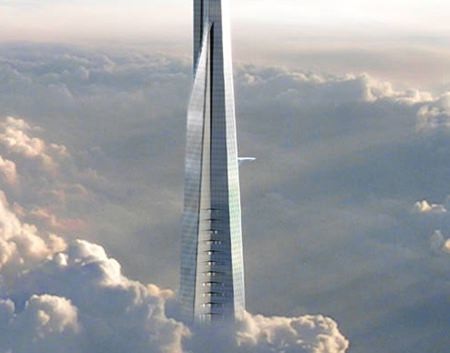The growth of the world’s tallest buildings continues to accelerate in the 21st century as demonstrated by Dubai’s 828m-high Burj Khalifa, towering more than 300 meters over the previous highest building, Taiwan’s Taipei 101 (509 meters). As soon as 2019, these will in turn be dwarfed by the Jeddah Tower (formerly Kingdom Tower) which will be the first 1-kilometre tall building, ensuring the size of the tallest building in the world will have doubled in just 10 years.
By 2020, the average total height of the tallest 20 buildings in the world is expected to be close to 600 meters, comparable to almost two Eiffel Towers, made possible by a combination of new technologies, innovative building materials and creative design elements.
Construction shift east
Alongside the continuous race for record heights, a strong geographical construction shift east is taking place. While throughout the 20th century the US skyscraper dominance was undisputed, the vast majority of construction projects today are in China, South East Asia and the Middle East. Dubai alone is already home to 20% of the world’s tallest 50 buildings, while China boasts 30 of the tallest 100 buildings across 15 cities. Indeed, China has announced plans for its own 1-kilometre tall building, the Phoenix Towers.
 A view from the clouds: Jeddah Tower in Jeddah, Saudi Arabia is expected to top out at over 1km in height when completed in 2019.
A view from the clouds: Jeddah Tower in Jeddah, Saudi Arabia is expected to top out at over 1km in height when completed in 2019.
“The construction shift east continues, driven by rapid economic and demographic growth, urbanization, strong investor appetite for flagship real estate assets and lower labor costs than in the traditional Western markets,” explains Ahmet Batmaz, Global Head of Engineering Risk Consulting at engineering insurer Allianz Global Corporate & Specialty (AGCS).
Elevators biggest obstacle to first mile-high building
Concepts for the first mile-high (1.6-kilometre) building already exist. However, they are unlikely to materialize for at least another 20 years – largely due to the fact that elevator technology is lagging behind building technology. Current technology limits elevator travel in today’s supertall and megatall buildings to around 600 meters, mainly due to challenges with braking and cabling, although this is expected to change in future.
Other limiting factors include the availability of building materials to potentially replace steel and concrete, but also safety measures for occupants and surrounding areas, damping systems to reduce the negative impact from wind or seismic activity, as well as financing such mega projects.
“The foundations of a supertall or megatall building need to be strong enough to even withstand an earthquake or other natural catastrophe activity,” says Clive Trencher, Senior Risk Consultant at AGCS. “In the initial building phase particularly, consideration also has to be given to potential exposures such as flash flooding, as there will be large excavations that could get filled with water.
“Other significant technical issues to overcome include pumping and placing concrete at extreme heights, maintaining verticality as the building height increases, fire risk and even water and sewage disposal,” he added.
(Source: AGCS)




